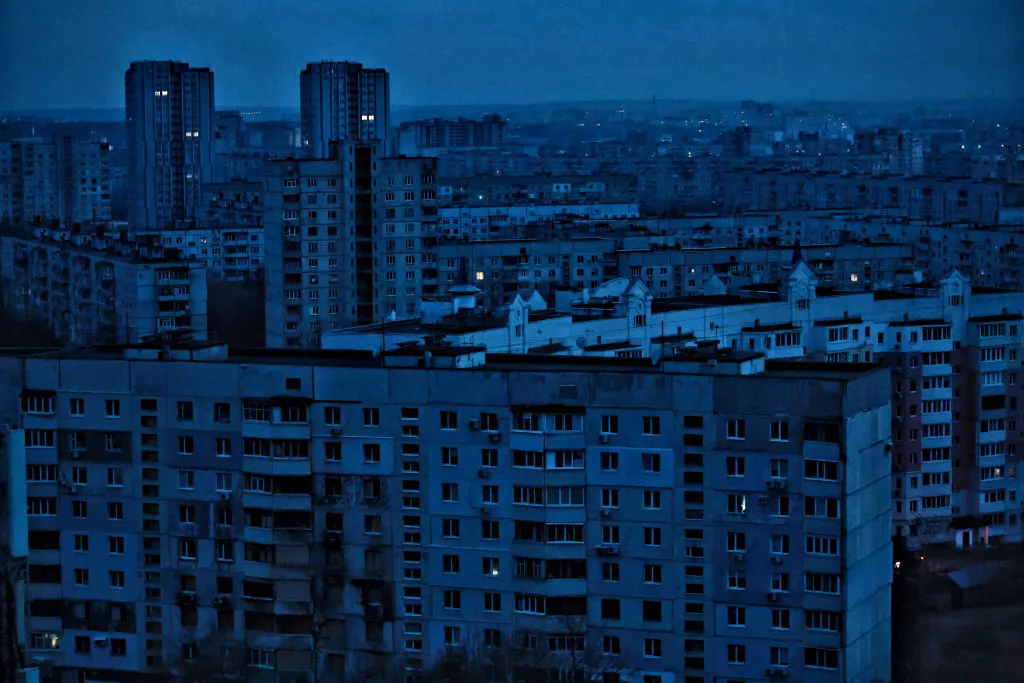A view of Kharkiv, Ukraine, on March 25, 2024, amid a city-wide blackout after a Russian on Ukraine's energy infrastructure on March 22, 2024. (Yan Dobronosov/Global Images Ukraine via Getty Images)
The collapse of Ukraine’s energy infrastructure last year due to Russia’s war brought the entire country to its knees. And while Ukraine was, for the most part, spared from widespread blackouts this winter, Russian forces are once again targeting critical infrastructure.
Russia resumed missile and drone attacks on Ukraine’s energy infrastructure in late March, leaving over a million consumers across the country without power. Around 700,000 people in Kharkiv Oblast, at least 200,000 people in Odesa Oblast, 200,000 people in Dnipropetrovsk Oblast, and 110,000 people in Poltava Oblast faced blackouts.
The nationwide attacks also intermittently disabled the power transmission lines feeding the Zaporizhzhia Nuclear Power Plant (ZNPP), the biggest nuclear site in Europe. International Atomic Energy Agency chief Rafael Grossi has said recent attacks mark a “major escalation” of nuclear danger in Ukraine.
Just last week, a Russian attack destroyed the Trypillia Thermal Power Plant (TPP), which was the main electricity supplier for Kyiv, Zhytomyr, and Cherkasy oblasts. Meanwhile, all major power plants supplying the city of Kharkiv are in ruins.
International human rights groups have decried Russia’s most recent attacks, calling them a violation of international humanitarian law. Meanwhile, the United Nations’ Independent International Commission of Inquiry on Ukraine said Russia’s indiscriminate attacks on Ukraine’s energy infrastructure throughout the war may amount to war crimes and crimes against humanity.
In addition to the military advantages afforded by decimating Ukraine’s power systems, Russia is using these attacks to de-populate Ukraine. Data derived by the Civil Network OPORA indicates that there may links between waves of migration from Ukraine and Russia’s attacks on energy infrastructure.
The number of people fleeing Ukraine, as well as displacing themselves internally, grew exponentially after the Russian military started to target the country’s energy infrastructure in October 2022. For example, the number of people leaving Ukraine increased by over 60% on Nov. 15 and Nov. 23 in 2022 after Russian attacks on Ukraine’s energy infrastructure led to large-scale blackouts.
Over 2.7 times more people left Ukraine on Nov. 16 after the energy attacks the day before as compared to Nov. 14. Similarly, 3.5 times more people left Ukraine on Nov. 24 after the attacks the day before as compared to Nov. 22. Observations are similar regarding the energy infrastructure attacks on Zhytomyr Oblast, Lutsk, and Kovel in October 2022 and Lviv in December 2022. Crucially, the vast majority of those leaving in the aftermath of these attacks are part of Ukraine’s working age population.
An increase in internally displaced persons (IDPs) has also been observed in the aftermath of Russia’s attacks on Ukraine’s energy infrastructure. From Oct. 6 to Oct. 12, 2022, alone, over 60,000 people left Zaporizhzhia and the surrounding region. Nearly 70% of the population of Nikopol District reportedly left amid attacks on the nearby ZNPP.
Pre-existing damage to Ukraine’s energy infrastructure, a lack of equipped personnel, shortage of air defense systems, are worsening this trend. President Volodymyr Zelensky attributed the destruction of the TPP to Ukraine running out of air defense to defend it. Meanwhile, Russia is only expanding its offensive capabilities, adding new Zircon and North Korean-made missiles to its arsenal.
Ukraine and Europe have a joint interest in preventing the decimation of Ukraine’s energy system. In order to do this, Ukraine needs to be given the means necessary to protect it, including air defense and equipment to repair damaged energy facilities. Russia must also be held accountable for its war crimes.
Original op-ed: Kyiv Independent
